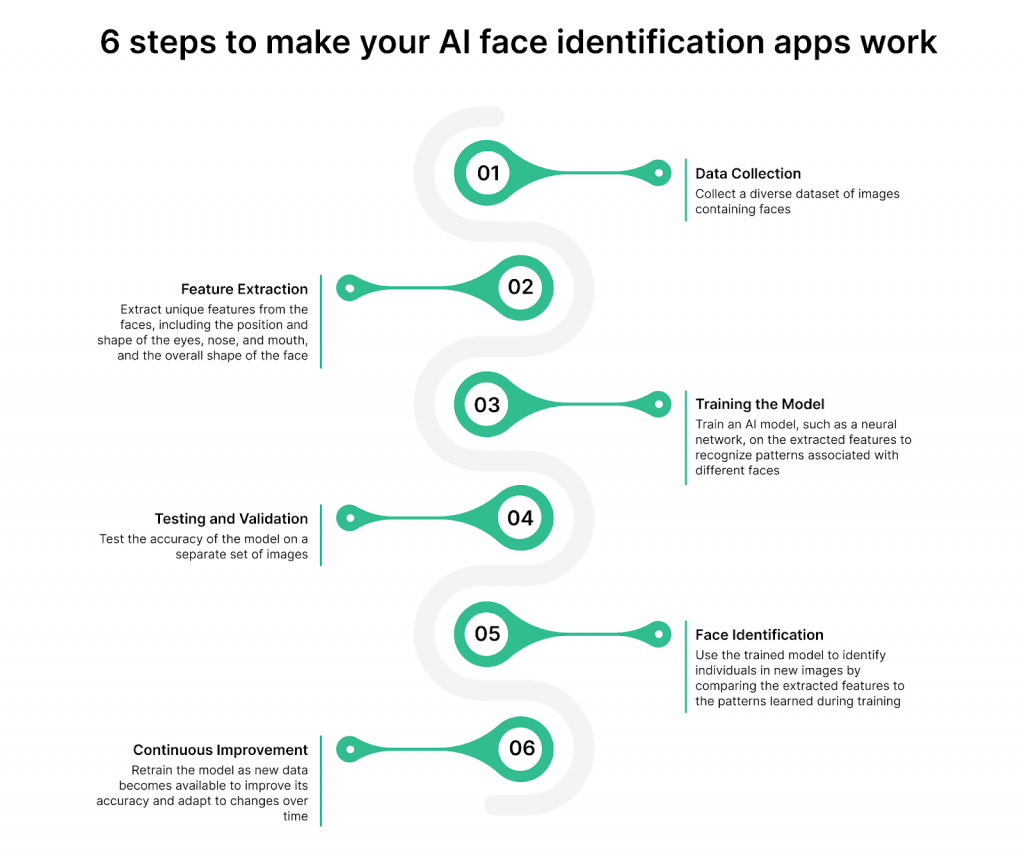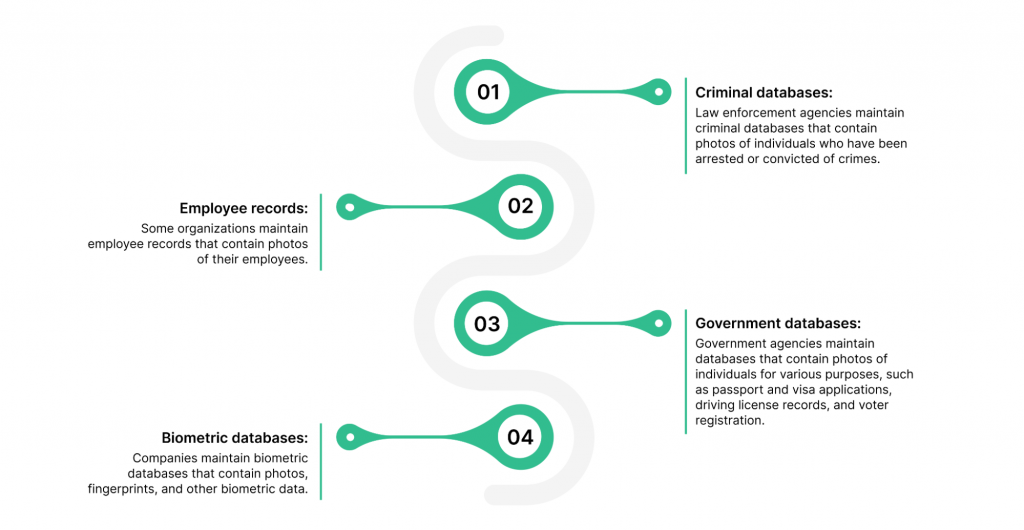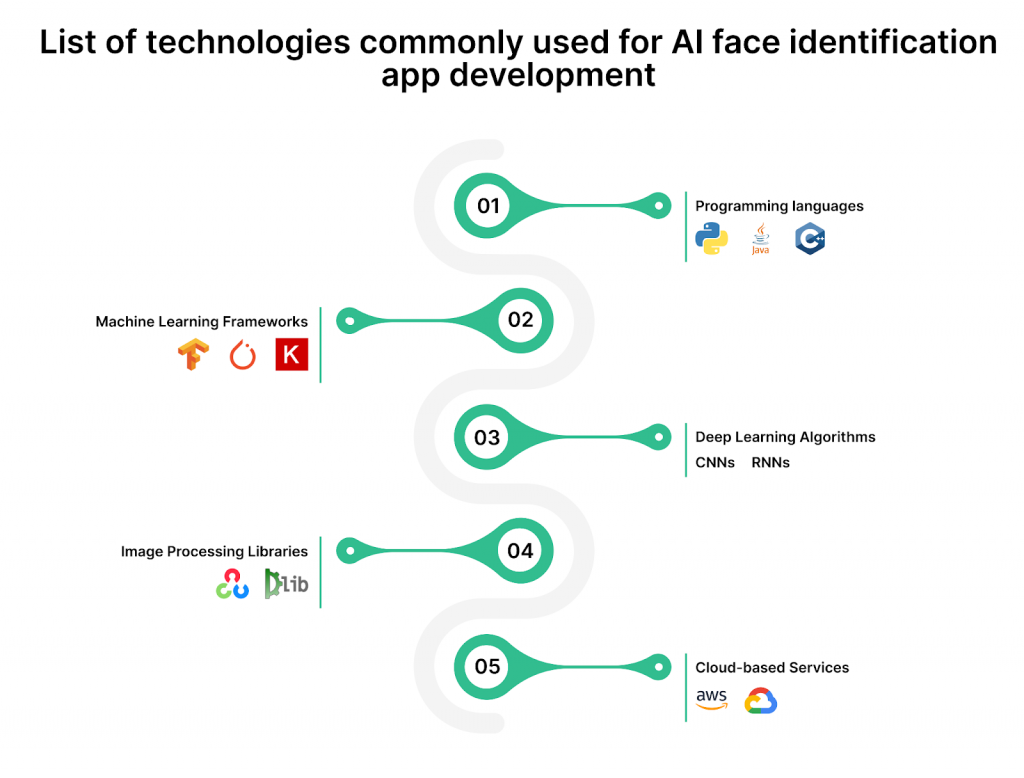Have you ever wondered how those popular face identification apps work? Well, get ready to dive into the world of artificial intelligence and learn how to create your own AI face identification app from scratch! In this comprehensive guideline, we’ll take you through every step of the process, from choosing the right tools and techniques to implementing advanced algorithms. Whether you’re a business leader or developer, this is one article you won’t want to miss.
Why AI face identification is crucial for businesses: top use cases
AI face identification is a technology that uses artificial intelligence algorithms to identify human faces in images or videos. In a business context, this technology can be used for various purposes, such as security, customer identification, and personalized marketing. The simplest example is human identification in the subway. Managing companies and state authorities need to know the transport daily load to ensure proper conditions for a convenient and safe user journey.
1. Security comes first
You can find lots of private and public entities that apply AI face identification applications for security purposes. For example, facial recognition systems can be used to grant access to secure areas of a building or to identify individuals who are on a watchlist. This can help prevent unauthorized access and enhance overall security measures.
2. KYC processes
Another way that enterprises can use the technology is for customer identification. By using facial recognition technology, businesses can quickly identify customers and access their purchase history, preferences, and other data that can be used to provide personalized marketing offers and improve customer experiences.
3. Dive into customer behavior
Last, but not least, AI face identification can also be used to analyze customer behavior, such as tracking how long they stay in certain areas of a store or how they interact with products. This data can be used to optimize store layouts, product displays, and marketing strategies.
The complexity and functionality of each AI face identification app are based on purposes. For some cases it’s enough to build an integration between a used security system and a ready-to-use tool. Talking about high-level purposes, businesses prefer to design a complex custom application covering multiple features.
Related: Top 10 Industries Using Artificial Intelligence: Facts, Insights, Use Cases
How IDAP creates cutting-edge AI face identification apps
We’re lucky to have dozens of challenging and fascinating customer requests. One of them strove to expand revenue streams by creating a tracking SaaS service that shows how many people visit corporate environments. The application processes uploaded video streams, analyzes them, and counts the number of visitors.
“We decided that the most efficient way here is to use computer vision, object recognition, and neural network learning. We knew several services capable of defining objects using photos, but they were too slow. For the first version, we took a ready-to-use tool YOLO. It’s an algorithm that uses neural networks for real-time object detection.”
Bogdan Kikacheishvili
iOS Lead, IDAP
We’re at the start of this development, which means the solution will be reached by broader functionality according to business needs. Anyway, it’s a bright example of how an AI identification application can be designed at a fraction of the cost and time.

From prices to functionality: how to build a full-fledged AI face identification app
How much does AI face identification app development cost?
The cost of developing a custom AI face identification app can vary greatly depending on the specific requirements and complexity of the project. However, some estimates suggest that the cost can range from $25,000 to $200,000 or more.
“It always depends on the functionality and complexity. For example, we’re talking about an employee tracking solution that shows each employee’s activity and detects their availability. In that case, we need to create an in-house database first, make an AI face identification app work using its resources, and build integration points with other software. It will take approximately 6+ months to roll out such a full-fledged solution.”
Bogdan Kikacheishvili
iOS Lead, IDAP
According to Statista, the global facial recognition market was valued at $3.8 billion in 2020 and is expected to grow to $8.5 billion by 2025, indicating the increasing demand for such applications.
It is important to note that developing a custom AI face identification app requires a team of experienced AI developers and data scientists who can create, train, and test the AI model. The cost can also depend on the technology stack used, the number of features included, the number of integration points built and the level of customization required.
Related: Custom App Development Cost [Update 2023]
Need more details? Ask the IDAP team for help! Get a free consultation with our top-notch specialists to prepare for your development project properly.
Top 10 features & capabilities of an AI face identification app: check-list
1. Face detection
The app should have a robust face detection feature that can identify and locate human faces in different lighting conditions and angles.
2. Facial recognition
Take care of a sophisticated facial recognition algorithm that can recognize and match faces with high accuracy.
3. Privacy
Ensure high level security and privacy features to protect user data and prevent unauthorized access.
4. User management
Another must-have feature covering user registration, access management and ensuring proper distribution of duties.
5. Integration with databases
The app should be able to integrate with various databases to match faces against a large pool of images.

6. Real-time processing
AI face identification apps should be able to perform real-time processing of images, enabling quick and accurate recognition of faces.
7. Customization
Flexibility is crucial for such apps. They should allow users to customize the recognition criteria, such as gender, age, and ethnicity, to improve the accuracy of the recognition process.
8. Reporting and analytics
Accurate and detailed reporting and analytics can help users track and analyze the recognition results to use it to improve processes and offerings.
9. Regulatory compliance
Depending on the use case, AI face identification apps may need to comply with specific regulations such as GDPR or CCPA. Developers need to ensure that the app meets these regulatory requirements.
10. Integration with other apps
The application should be able to integrate with other software, such as security and access control systems, to provide a comprehensive solution for face identification and recognition.

Related: What is Flutter for Business Leaders and Tech Specialists in 2023?
How many specialists do you need to create a full-fledged AI face identification app?
The number of tech specialists required for developing an AI face identification app from scratch will depend on the scope of the project, the complexity of the algorithms, and the timeline. However, typically, a development team will require at least five to six members, each with specialized skills, to cover the different aspects of the development process.
The team should include:
- AI/ML Engineers
- Software Developers (Frontend & Backend)
- Data Scientists
- UX designers
- QA Engineers
- Security Specialists
- Project Managers
Related: Why Project Managers are Driving Software Development Process: 101 Guideline for Business Leaders
Depending on the requirements of the project, the team size may need to be adjusted to include additional specialists such as Database Administrators, Cloud Architects, or DevOps Engineers.
In general, the team size should be balanced between having enough specialists to cover all the necessary areas while also avoiding an overly large team that could lead to communication difficulties and project management challenges. Ultimately, the goal is to have a skilled and efficient team that can work together seamlessly to deliver a high-quality AI face identification app.
Looking for a reliable team to bring your face identification app to life? Look no further than the IDAP team. Contact us to discuss your project needs.
How to design a robust AI face identification app: step-by-step guideline
1. Discovery
In this stage, developers collect requirements and analyze the feasibility of developing an AI face identification app. They identify the target audience, use cases, and expected outcomes. Developers may also conduct research to determine the technology and tools required to develop the app.
2. Roadmap creation
Here, the tech team creates a plan for developing the app. They determine the features, functionalities, and the overall design of the app. Developers may create user personas, user stories, and use case diagrams to help them in this stage.
3. Development
Engineers start building the app. They use programming languages such as Python, Java, or C++ to write the code for the app. Specialists also incorporate machine learning algorithms, computer vision libraries, and facial recognition APIs to enable the app to identify faces accurately.
4. Testing
QA Engineers test the app to ensure it is functioning correctly. They perform unit, integration, and acceptance testing to identify and fix any bugs in the app. They can also apply load testing to ensure the app can handle a large number of users.
5. Deployment
The team deploys the app to the production environment. Engineers ensure the app is running smoothly and is accessible to users. They may also perform stress testing to ensure the app can handle high traffic volumes.
6. Maintenance
At this stage, the tech team maintains the app to ensure it remains functional and up-to-date. It fixes any errors that users report and incorporate new features and functionalities. Developers also monitor the app’s performance and security to ensure it remains secure and free from vulnerabilities.
Summary
AI face identification apps are becoming increasingly popular due to their ability to recognize faces quickly and accurately. Are you ready to try their powers and capabilities soon and see their effect on your business development? Involve the IDAP team in developing a robust solution at a fraction of the cost and time. Drop us a line to tell more about your idea. Let’s work together to achieve impressive results on a tight schedule!



